|
June 17-20, 2013
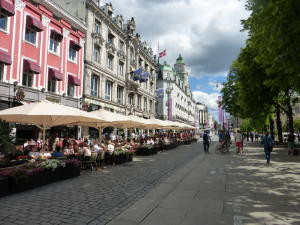 After
our cruise, we spent 3 days on our own in Oslo. We stayed at the
Thon Hotel Munch which was a very comfortable, clean, budget ($180/night)
hotel with an excellent included breakfast. It was within easy walking
distance of the city center and public transportation. We bought
the Oslo Pass for $35 which gave us access to all museums/attractions
as well as free transportation on buses, ferries and trains. It
was a definite bargain - and the only bargain in Oslo! Like Copenhagen,
Oslo is a very expensive city. Even a McDonald's Big Mac was $12! After
our cruise, we spent 3 days on our own in Oslo. We stayed at the
Thon Hotel Munch which was a very comfortable, clean, budget ($180/night)
hotel with an excellent included breakfast. It was within easy walking
distance of the city center and public transportation. We bought
the Oslo Pass for $35 which gave us access to all museums/attractions
as well as free transportation on buses, ferries and trains. It
was a definite bargain - and the only bargain in Oslo! Like Copenhagen,
Oslo is a very expensive city. Even a McDonald's Big Mac was $12!
 We
really enjoyed our stay in Oslo and got to visit many of the major
attractions. Our first day we walked down to the harbor area and
took the free tour of City Hall. Built mostly in the 1930's, it
is richly decorated with huge murals by leading Norwegian artists
depicting Norwegian life and history. It is also where the Nobel
Peace Prize is given out each year. We then joined the free guided
walking tour of the old part of Oslo which was interesting, though
a bit too long! We
really enjoyed our stay in Oslo and got to visit many of the major
attractions. Our first day we walked down to the harbor area and
took the free tour of City Hall. Built mostly in the 1930's, it
is richly decorated with huge murals by leading Norwegian artists
depicting Norwegian life and history. It is also where the Nobel
Peace Prize is given out each year. We then joined the free guided
walking tour of the old part of Oslo which was interesting, though
a bit too long!
 On
our second day we took the #12 trolly to Frogner Park and the Vigeland
Sculpture Garden. This 75 acre park contains a lifetime of work
by Norway's greatest sculptor, Gustav Vigeland. In 1921 he made
a deal with the city. In return for a studio and state support,
he'd spend his life beautifying Oslo with this sculpture garden.
He worked on-site from 1924-1943, designing 192 bronze and granite
statue groupings, 600 figures in all. Entering the park, there is
a 300 foot long bridge lined with 58 bronze statues. The statues
are a general study of the human body, many dealing with the relationship
between people. On
our second day we took the #12 trolly to Frogner Park and the Vigeland
Sculpture Garden. This 75 acre park contains a lifetime of work
by Norway's greatest sculptor, Gustav Vigeland. In 1921 he made
a deal with the city. In return for a studio and state support,
he'd spend his life beautifying Oslo with this sculpture garden.
He worked on-site from 1924-1943, designing 192 bronze and granite
statue groupings, 600 figures in all. Entering the park, there is
a 300 foot long bridge lined with 58 bronze statues. The statues
are a general study of the human body, many dealing with the relationship
between people.  Continuing
over the bridge through the rose garden, you come to a huge fountain
(it was not in operation while we were there). Six giants hold the
fountain, symbolically toiling with the burden of life. 20 tree-of-life
groups surround the fountain showing humanity's relationship to
nature and the seasons of life: childhood, young love, adulthood
and winter(old age). The centerpiece of the park is the monolith.
121 figures are carved out of a single block of stone. Three stone
carvers worked 14 years to cut Vigeland's full size plaster model
into the final 180 ton, 50 foot tall monolith.It is surrounded by
36 granite groups which continue Vigeland's cycle-of-life motif. Continuing
over the bridge through the rose garden, you come to a huge fountain
(it was not in operation while we were there). Six giants hold the
fountain, symbolically toiling with the burden of life. 20 tree-of-life
groups surround the fountain showing humanity's relationship to
nature and the seasons of life: childhood, young love, adulthood
and winter(old age). The centerpiece of the park is the monolith.
121 figures are carved out of a single block of stone. Three stone
carvers worked 14 years to cut Vigeland's full size plaster model
into the final 180 ton, 50 foot tall monolith.It is surrounded by
36 granite groups which continue Vigeland's cycle-of-life motif.
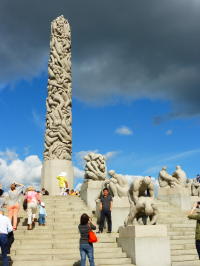 Afterwards
we visited the Vigeland museum which contains the original plaster
and clay casts of the sculptures and information on how these were
used to create the granite and bronze statues in the park. To view
more photos of Vigeland Sculpture Garden, go to Vigeland
Photo Gallery. Afterwards
we visited the Vigeland museum which contains the original plaster
and clay casts of the sculptures and information on how these were
used to create the granite and bronze statues in the park. To view
more photos of Vigeland Sculpture Garden, go to Vigeland
Photo Gallery.
From Frogner Park, we took the #1 tram to Holmenkollen Ski Jump
and Ski Museum. This is the site of one of the world's oldest ski
jumps (from 1892) and the site of the 1952 Olympics. To win the
privilege of hosting the 2011 World Ski Jump Championships, Oslo
built a bigger jump to match more modern ones built elsewhere.  We
took the tilted elevator to the top of the jump and looked down
on the 50,000 seat amphitheater below. Quite a site. The ski museum
was also very interesting as it traces the evolution of the sport,
from 4000 year old rock paintings, to 1500 year old wooden sticks,
to today's modern skis. (Go to Oslo
Photo Gallery to see more photos of Holmenkollen.) We
took the tilted elevator to the top of the jump and looked down
on the 50,000 seat amphitheater below. Quite a site. The ski museum
was also very interesting as it traces the evolution of the sport,
from 4000 year old rock paintings, to 1500 year old wooden sticks,
to today's modern skis. (Go to Oslo
Photo Gallery to see more photos of Holmenkollen.)
On our final day in Oslo, we took the mini cruise on an old wooden
schooner over to Bygdoy Peninsula. Bygdoy is home to the open-air
Norwegian Folk Museum as well as several interesting museums housing
famous ships. 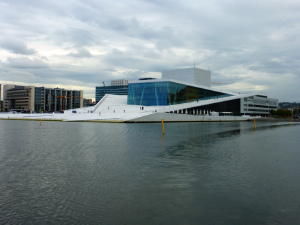 On
our way over to Bygdoy, we sailed past the new Opera House which
opened in 2008. On Bygdoy, we started by walking around the Norwegian
Folk Museum. 150 buildings have been brought from all corners of
Norway and reassembled here on 35 acres. It presents life in Norway
from 1500 to the present day. The Old Town area has buildings from
Oslo and other Norwegian towns. The Countryside section shows typical
farms from different districts and time periods. On
our way over to Bygdoy, we sailed past the new Opera House which
opened in 2008. On Bygdoy, we started by walking around the Norwegian
Folk Museum. 150 buildings have been brought from all corners of
Norway and reassembled here on 35 acres. It presents life in Norway
from 1500 to the present day. The Old Town area has buildings from
Oslo and other Norwegian towns. The Countryside section shows typical
farms from different districts and time periods.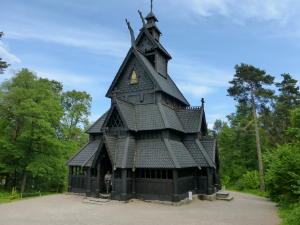 There is also an old Stave Church built in Gol around 1200 and relocated
to its present site in 1884.
There is also an old Stave Church built in Gol around 1200 and relocated
to its present site in 1884.
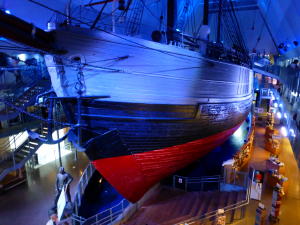 Our
next stop was the Fram Museum which houses the 125 foot ship that
took Roald Amundsen and Fridtjof Nansen deep into the Arctic and
Antarctic. The Fram was both sail and steam powered and was specially
designed to survive the crushing pressures of a frozen over sea.
For 3 years, the Fram drifted, trapped in the Arctic ice. Our
next stop was the Fram Museum which houses the 125 foot ship that
took Roald Amundsen and Fridtjof Nansen deep into the Arctic and
Antarctic. The Fram was both sail and steam powered and was specially
designed to survive the crushing pressures of a frozen over sea.
For 3 years, the Fram drifted, trapped in the Arctic ice.
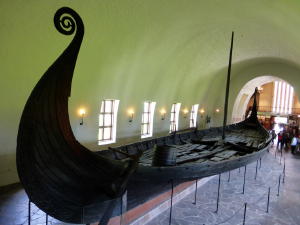 Then
we entered the Viking Ship Museum which houses two finely crafted
and well preserved Viking ships as well as other excavated items
from the 9th and 10th centuries. They were buried in clay and were
unearthed as part of gravesites. Then
we entered the Viking Ship Museum which houses two finely crafted
and well preserved Viking ships as well as other excavated items
from the 9th and 10th centuries. They were buried in clay and were
unearthed as part of gravesites.
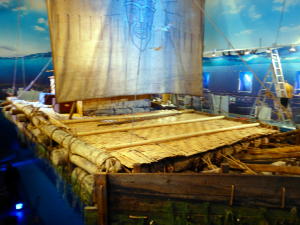 Our
final stop was to the Kon-Tiki Museum which houses both the Kon-Tiki
and the Ra II. The Kon Tiki was built by Thor Heyerdahl in 1947
out of balsa wood using pre-modern techniques and tools. The Kon-Tiki
sailed from Peru to Polynesia, 4300 miles in 101 days. The purpose
was to prove South Americans could have settled Polynesia. The journey
was chronicled in Heyerdahl's book "Kon-Tiki". Our
final stop was to the Kon-Tiki Museum which houses both the Kon-Tiki
and the Ra II. The Kon Tiki was built by Thor Heyerdahl in 1947
out of balsa wood using pre-modern techniques and tools. The Kon-Tiki
sailed from Peru to Polynesia, 4300 miles in 101 days. The purpose
was to prove South Americans could have settled Polynesia. The journey
was chronicled in Heyerdahl's book "Kon-Tiki". 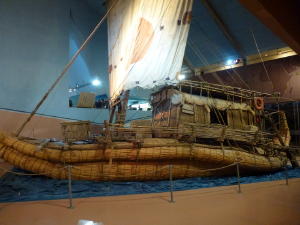 In
1970, Heyerdahl's Ra II made a 3000 mile journey from Morocco to
Barbados to prove that Africans could have populated America. Looking
at these ships, it is truly a wonder that either was able to make
the journey. In
1970, Heyerdahl's Ra II made a 3000 mile journey from Morocco to
Barbados to prove that Africans could have populated America. Looking
at these ships, it is truly a wonder that either was able to make
the journey.
To view more photos from Bygdoy, go to
Bygdoy Photo Gallery.
The next day we took the fast train (Flytoget) to the airport and
our long, but uneventful trip, home. It was an amazing vacation
and one we'd highly recommend to others.
To view general photos from around Oslo, including Holmenkollen
Ski Jump, please go to Oslo Photo
Gallery. Photos from Vigeland Sculpture Garden are in the Vigeland
Photo Gallery. Photos from Bygdoy are in Bygdoy
Photo Gallery.
Home
Locations Visited Photos Map
Contact Us
|
.jpg)